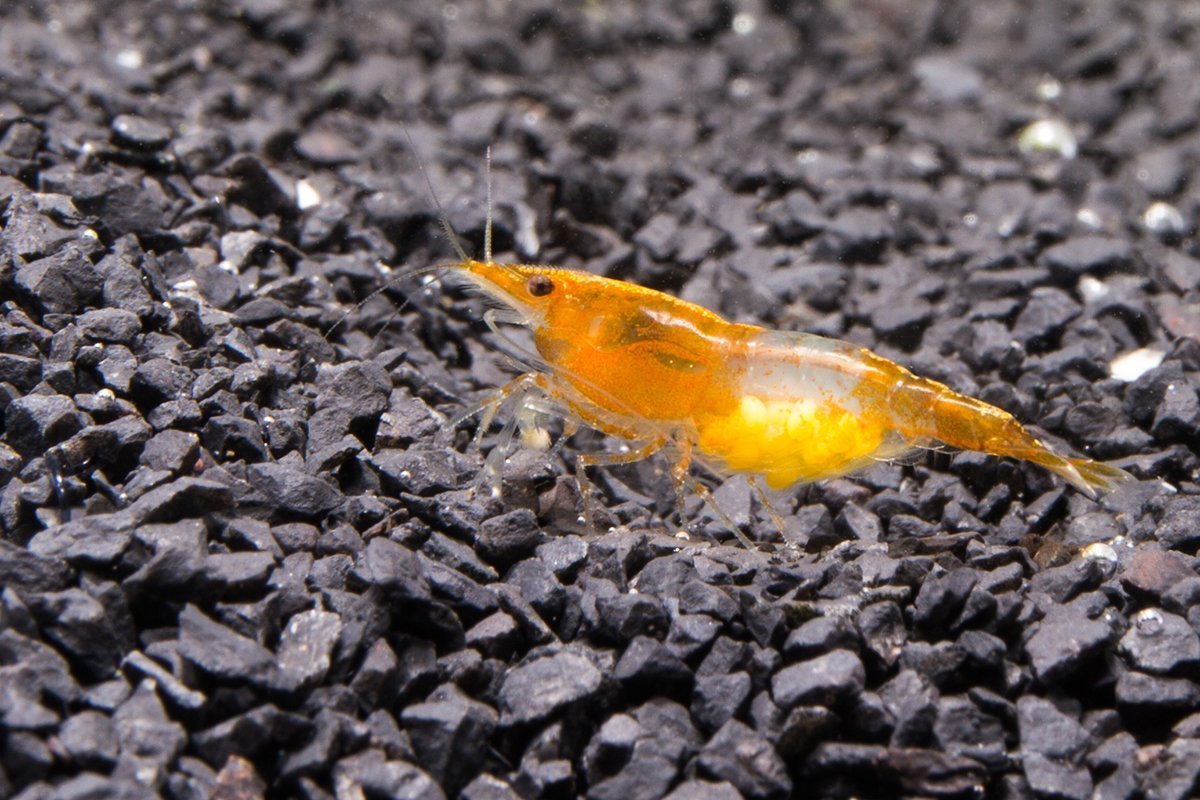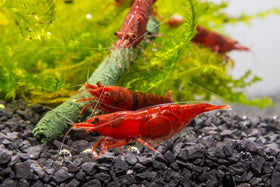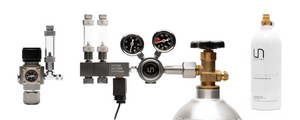
Guide: How to Breed Freshwater Shrimp
Written by: Gracie Mandel
There is nothing more exciting and satisfying than a thriving colony of beautiful shrimp that you bred yourself. This might seem like a daunting ordeal to take on, but I promise you that with my basic tips, your shrimp will want to breed for you! Before you know it, you may even end up with more shrimp than you ever thought you could.
Of course there are the basic needs that must be met for shrimp to survive. Although, there are also some helpful tips you can follow to increase the likelihood of your shrimp breeding.
This article will cover both. I will go over the essentials, as well as some suggestions and tricks that I have learned along the way in my own shrimp-breeding experience including:
THE BARE (BUT VITAL) NECESSITIES

Breeding Tanks by @cornertankcorner on Instagram
FILTRATION
Many people believe that the job of an aquarium filter is to simply keep the water looking clean. While this is certainly true, they are also responsible for crucial aspects of a healthy shrimp tank.
Sponge Filters: The not-so-sleek option, but most inexpensive. Prolific shrimp-breeders almost always recommend these over other filters due to their gentle flow and because they ensure baby shrimp cannot get sucked in. An exceptional choice is the Qanvee Sponge Filter. It has double sponges, and two chambers of bio-media to really maximize the beneficial bacteria capacity.
Hang On Back Filters: Easily hidden and stay out of the way of your hardscape. Also available at almost every fish store; chain or local. There is a possibility shrimp can get sucked into the intake, but an easy fix is to purchase or “DIY” an intake sponge to prevent this. If you are looking for an especially inconspicuous and attractive model, consider the The Mighty Aquarium hang-on back filter, (it even comes with an intake sponge).
Canister Filters: Almost imperceptible in the tank due to the option of clear lily pipes. They have unparalleled levels of filtration. However, they do require storage under or next to the tank because they are larger than other filters, and are normally recommended for larger tanks. Luckily for us nano-tank lovers they do make smaller options, such as the Ultum Nature Systems DELTA 60.
WATER PARAMETERS
Possibly the most important takeaway from this article. With the proper water parameters, your shrimp will not only survive, but they will thrive or breed. I will give an overview of the optimal water parameters for three different shrimp species. However, depending on where or who you acquire your shrimp from, you may go outside the parameters by a few degrees if they have been raised differently. Definitely try to replicate the parameters they come from. And don’t forget, the most important factor, even over perfect parameters, is keeping them consistent. I’ll say it again for the people in the back: shrimp do not like sudden changes!
NEOCARIDINA DAVIDI (THE HARDY HEROES) GENERAL PARAMETERS

CARIDINA CANTONENSIS (THE DELICATE FLOWERS) GENERAL PARAMETERS

CARIDINA SERRATA (THE TRANQUIL TIGERS) GENERAL PARAMETERS

To achieve these parameters, water remineralizers are a great option to create optimal environments, especially if you are using RODI (Reverse-Osmosis) water for your more delicate caridina shrimp. Most neocaridina can be kept in tap water, as long as you use a dechlorinator.
Of course, these are just the recommended numbers. Although, studies show that temperature may play a larger role in controlling breeding than we thought. According to research, higher temperatures cause a shorter overall lifespan, a faster metabolism, but more speedy breeding. Lower temperatures have proven longer lifespans and slower metabolisms; however less breeding occurs and the breeding cycle may take longer. Obviously, the middle ground temperatures are preferable, but it is up to you after taking these factors into account.
TESTING KITS
Testing kits are an essential item for any aquarium hobbyist or breeder. A water-test kit is one of the first items you should buy during the cycling phase. Once your test kit reads 0.0 ammonia, 0.0 nitrite, and less than 20 ppm nitrate, you can be confident your tank has cycled. They are also especially necessary for Caridina shrimp breeders because of their very specific water parameter requirements. A test kit is a surefire way to make sure your water stays consistent (yes, I had to say it again)!
HELPFUL TOOLS AND TIPS
FOR INCREASING BREEDING & SURVIVAL:

My berried Fire Red Cherry Shrimp Fanning Her Eggs
FEEDING
A good varied diet will certainly encourage shrimp growth, healthy molts, and breeding. The best types of food are generally:
Biofilm: It grows on many surfaces; such as the glass, hardscape, and plants. This should be the main source of food for your shrimp, and the reason a well-established tank is extremely beneficial.
High Quality Pellets: Premium-grade manufactured foods can be a great supplement if shrimp are lacking in certain nutrients and minerals, such as protein, calcium, and vegetable-based nutrition. Shrimp need vitamins just like humans, so keep these foods in rotation for a well-balanced diet.
Natural Foods: Fresh, blanched vegetables, such as spinach, zucchini, carrots, cucumber, etc. are all nutritious ways to diversify your feeding and provide minerals. Leaves are also advantageous options that are often overlooked. In their natural environment, shrimp are often surrounded by leaf litter from trees above. Leaves such as Indian Almond, Walnut, and Moringa, are perfect for creating surface area for biofilm, and the shrimp will munch on the leaves themselves. They also provide antifungal properties, and should be included in every setup.

Shrimp on a Leaf by @cornertankcorner on Instagram
Powdered Foods/Supplements: Bacteria powder products such as SL-Aqua Milione and SL-Aqua Vitality contain beneficial bacteria and minerals that promote valuable tank organisms, as well as assist in shrimp and shrimplet health, immunity, growth, and digestion. Specific powdered food for babies and shrimplets can make it easier for them to access since their fine particles spread throughout the tank, and have the nutrients they need to grow.
A feeding dish is a helpful item to have. It allows you to see how much your shrimp are actually eating (to avoid overfeeding), and prevents the food from falling into, and fouling, the substrate. You can buy a specific feeding dish, but it is just as easy to use objects you already own, such as glass bowls or small terracotta plates.

Crystal Red Shrimp on Terracotta Feeding Dish by @the_shrimpdom on Instagram
PREDATORS
Keeping fish with shrimp can be a topic of controversy. Many people say that there are “shrimp-safe” fish. Typically, nano fish like micro rasbora, endlers, small tetras, and especially otocinclus are considered relatively harmless. They have small mouths, and mild temperaments. 
Neon Tetra Fish by @shrimpletscaping on Instagram
If you are serious about breeding shrimp, you want to produce as many as possible and make sure your baby shrimp stay safe, it is recommended to keep a 100% fish-free tank. Even otocinclus, that have been said to be 99% safe from eating your shrimp, can on occasion accidentally swallow a small newborn shrimp.
HIDING SPOTS
This brings us to shrimp hideouts. Especially if you are planning on keeping fish in your tank, having multiple areas for shrimp to hide is advantageous. Even in a shrimp-only tank, they will be thankful to have areas in the tank to hide out and take cover from light, after molting, and other stressors. There are many options to choose from, and you can have different types.
Shrimp-Specific Hides: Man-made hideouts such as driftwood shrimp tunnels, cubes, or coconut caves.

Cholla Driftwood Tunnel Tube for Shrimp
Keeping a variety of hardscape and plants in your shrimp tank can provide many hiding spaces, as well as providing surface area for biofilm to grow.
Rocks & Stones: My personal favorite stone for aquascaping and providing shelter is the Dragon Stone, also known as Ohko Stone. It is an inert stone, making it optimal to keep water parameters consistent. It also has natural crevices and holes perfect for sticking moss or other aquatic plants inside, or allowing shrimp to crawl into. Lava Rocks are also perfect for shrimp tanks. They are very versatile. They are lightweight enough that you can use them to build your own caves or designs. They are also porous by nature, which makes them perfect for harboring beneficial bacteria. Both of these options have a consistency that makes them easy to break into smaller pieces, allowing even more stones to add to your aquascape.

Dragon Stone Aquascape by BucePlant
Wood: Hardscaping wood such as Driftwood is perfect for a multitude of reasons. It releases tannins that recreate the natural habitat shrimp are found. Shrimp also love munching off of the films that grow on it.

Cherry Shrimp Flexing on Driftwood by @shrimpletscaping on Instagram
Cholla Wood is often found in shrimp tanks due to its tubular-shape, and holes, which provide the perfect hiding spot for shrimp.
Wood, stones, and rocks can also be great anchors to tie or glue moss and other plants on to. You can even buy decorative pieces that are pre-made for you.
Moss & Aquatic Plants: Both moss and other aquatic plants are very important in a shrimp-breeding setup. Not only do they help filter out ammonia and nitrate, shrimp love hiding and grazing in them. Floating plants are great at absorbing harmful compounds and they also provide shade from bright-light. I often catch my shrimp hanging at the surface of the tank munching on the roots of floating plants. Their long roots often become coated in powdered food and bacteria.
Similarly, moss is a favorite for shrimp to pick through and eat from. Moss is extremely forgiving, and requires very little light or nutrients to grow. Bucephalandra, Anubias, and Ferns are all shrimp-tank staples. These undemanding plants can be wedged into nooks of rocks and hardscape, or attached to wood and other shrimp hideouts. They come in many sizes, and their leaves can grow algae and biofilm, which your shrimp will enjoy eating. Truthfully, any type of plant will be of benefit to your shrimp breeding.

A Cherry Shrimp Resting on a Bucephalandra Plant by @shrimpletscaping on Instagram
-
By the way: Don’t be afraid of snails! Snails provide many benefits such as: aerating the substrate, eating the leftover food and debris, cleaning your plants, and their poop provides more food for shrimp! They are a great part of a well-balanced ecosystem.
QUALITY STOCK
It may be enticing to purchase those shrimp you saw online for a great deal. Why shouldn’t you buy those shrimp that are imported overseas for a reduced price? Well, there is a reason you want to invest in quality. Buying from local breeders, or from well-known, well-reviewed websites ensures that you receive the best quality shrimp possible. When you buy from these options, not only are you supporting true hobbyists, and not someone trying to make a quick buck, but you will be better off in the long-run. These shrimp will be much healthier, and are much less likely to come with diseases such as Ellabiopsidae, Scuttarelia or Vorticella. Although treatable, the last thing you want to deal with is medicating shrimp and stressing them further. When you buy from a trusted source, you can ask questions and gain info about the specific parameters they are being kept in (for example, each of BucePlant’s shrimp pages contains specific information about difficulty of care, recommended parameters, and the parameters they are keeping them in). You can also ask to be sent younger (juvenile) shrimp. Often, the large, bright-colored shrimp are full-grown adults and have a shorter lifespan. Starting with younger shrimp gives them a better chance at adapting to your tank and living longer, therefore producing more babies.
TANK SIZE
Tank sizing is entirely up to you. I, as well as many people, have been successful in breeding shrimp in tanks as small as two and three gallons. But, if you want to have the best luck, a ten gallon tank is a great starting place. The size makes it less likely to experience parameter or temperature fluctuations. Just make sure you have a decent group of shrimp to start (at least 10-15) so that the males won’t have a hard time finding the females.
JOIN A GROUP
What better way to learn about shrimp than from experts and shrimp-breeders themselves? There are so many online groups and forums specific to shrimp keeping that accept beginners and experts alike. Don’t be afraid to ask questions! Most hobbyists want to help you be successful, because that in turn makes the hobby more accessible and larger. Check out Buce Plant's Facebook aquascaping community, Team Buce Plant, by clicking HERE.

Crystal Red Shrimp by u/StockRaker on Reddit
I hope these tips were helpful for those of you looking to expand your shrimp colony. Shrimp want to breed and they will, given the right environment. Good luck and happy breeding!
Ready to start your own shrimp tank? Click here to check out Buce Plants Premium Shrimp Packs!
Tell us - Are you a shrimp breeder? Comment your thoughts!
If you have any questions regarding this article, please DM us on Facebook or Instagram so we can assist you! @buceplant






Leave a comment